Abstract
By measuring the distribution of conduction velocities (DCV) in sensory fibres of the median nerve, the effects of asymptomatic increased lead, zinc, and copper absorption on the conduction velocities of slower and faster nerve fibres were examined in 29 gun metal founders with blood lead (BPb) concentrations of 22-59 (mean 39) micrograms/dl (1.1-2.8 (mean 1.9) mumol/l). The results indicated that the conduction velocities of slower fibres were inversely affected by lead absorption, resulting in a significant reduction in the velocities at the BPb level of 40-59 micrograms/dl; on the other hand, the conduction velocities of faster fibres and the conventional sensory nerve conduction velocity were presumably positively affected by zinc absorption without a significant reduction in the velocities of faster fibres. It is suggested that assessment of the possible antagonistic effect of zinc is essential when conduction velocities are not decreased in lead exposed workers.
Full text
PDF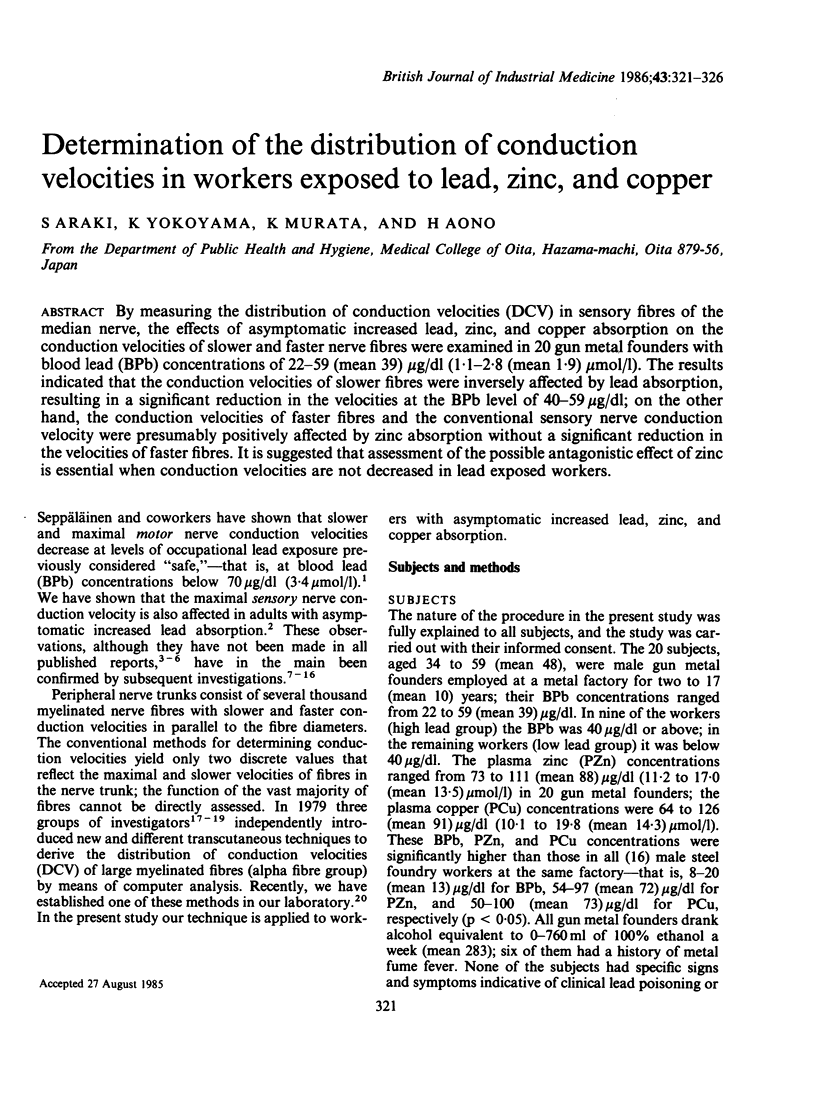
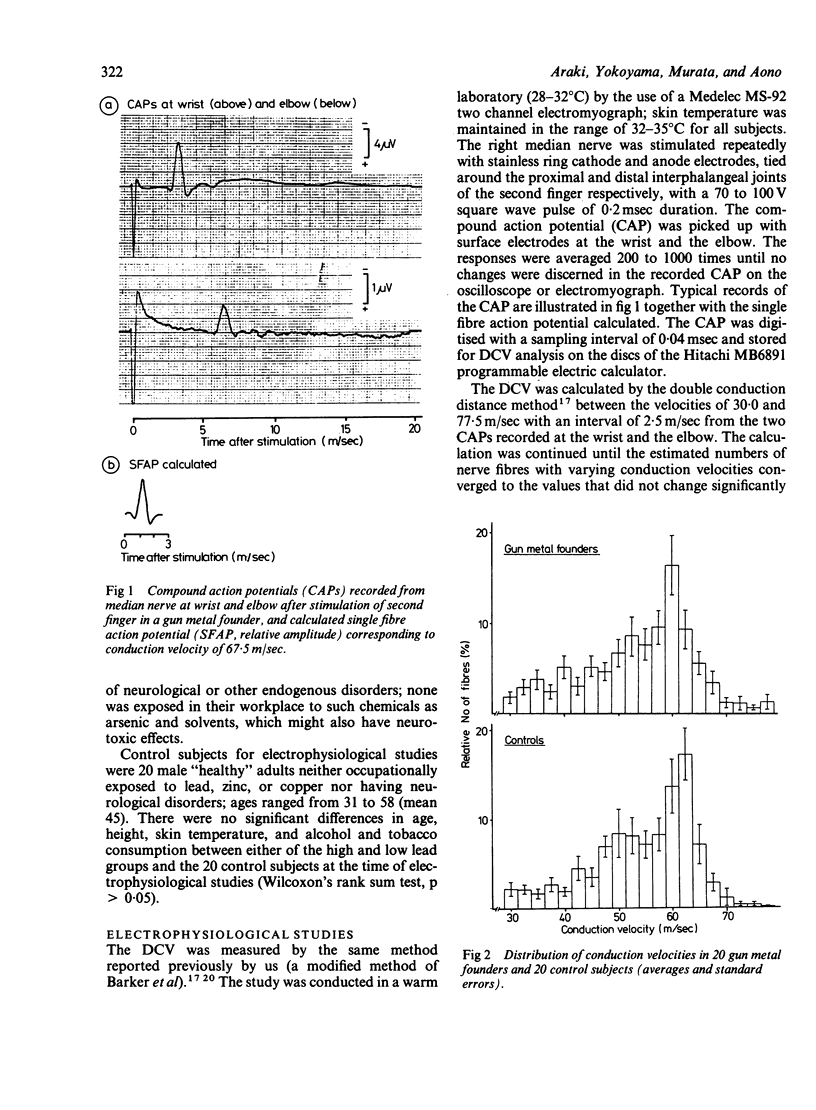
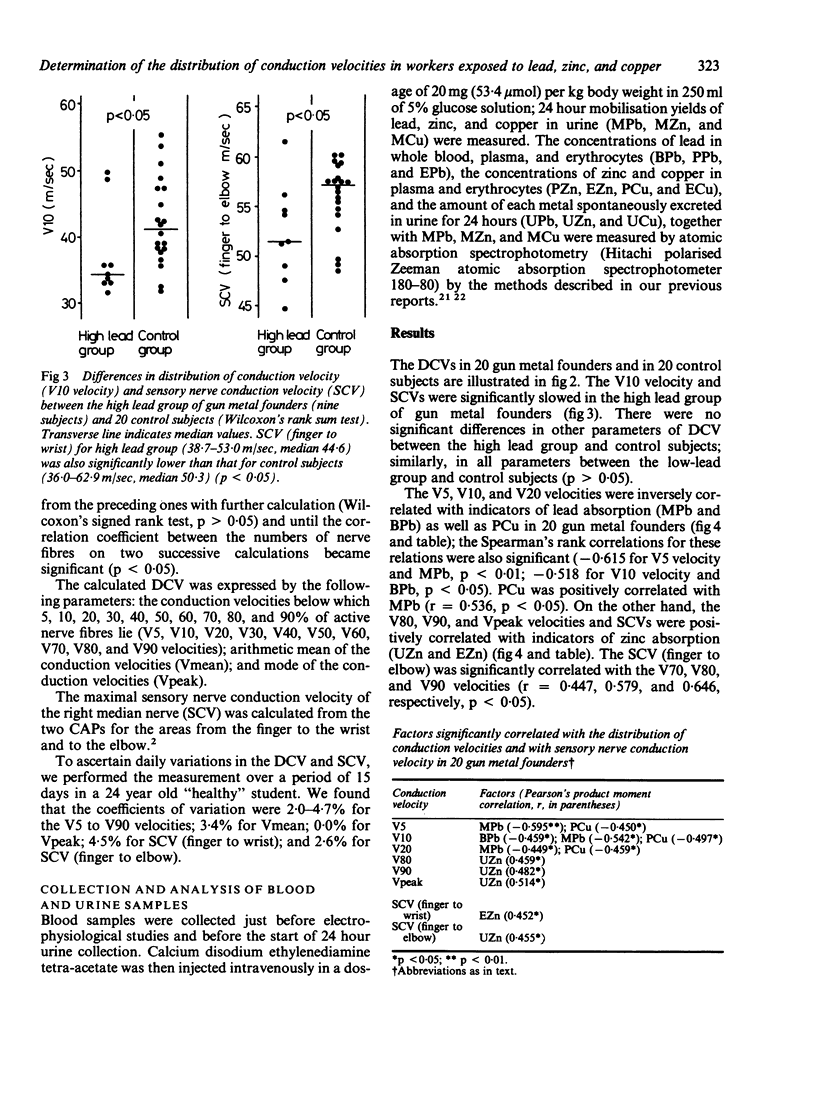
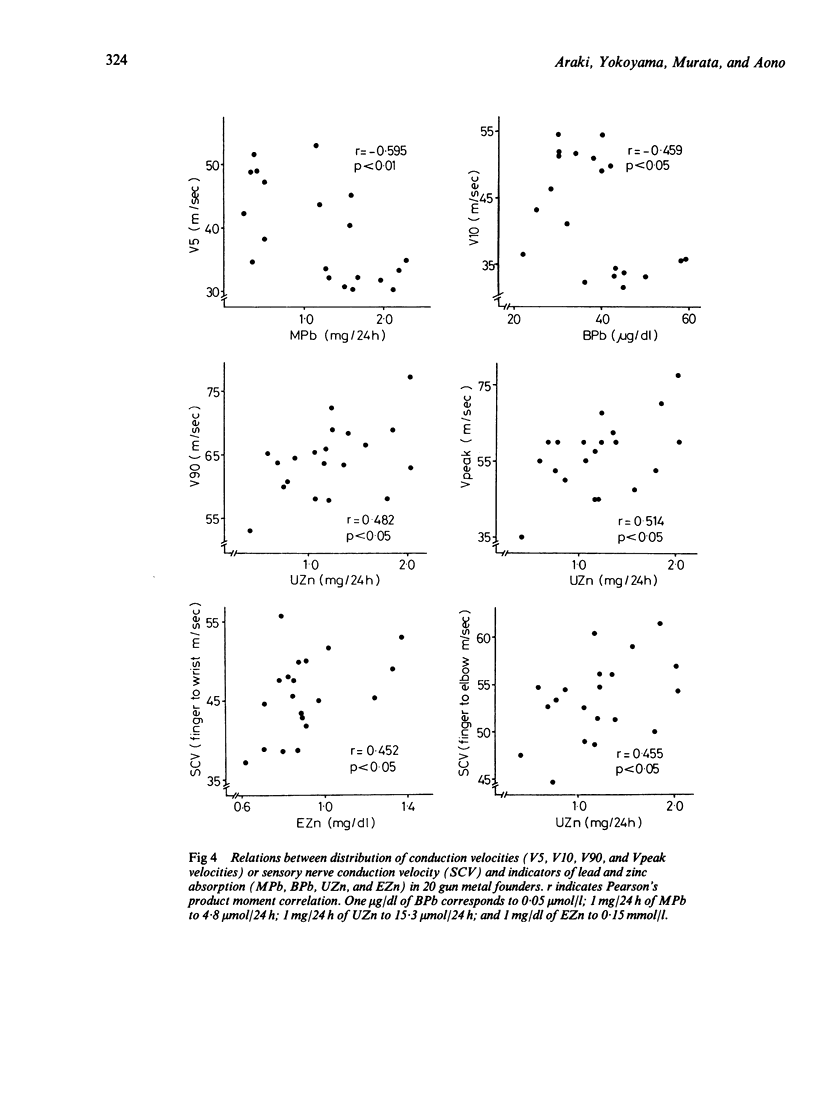
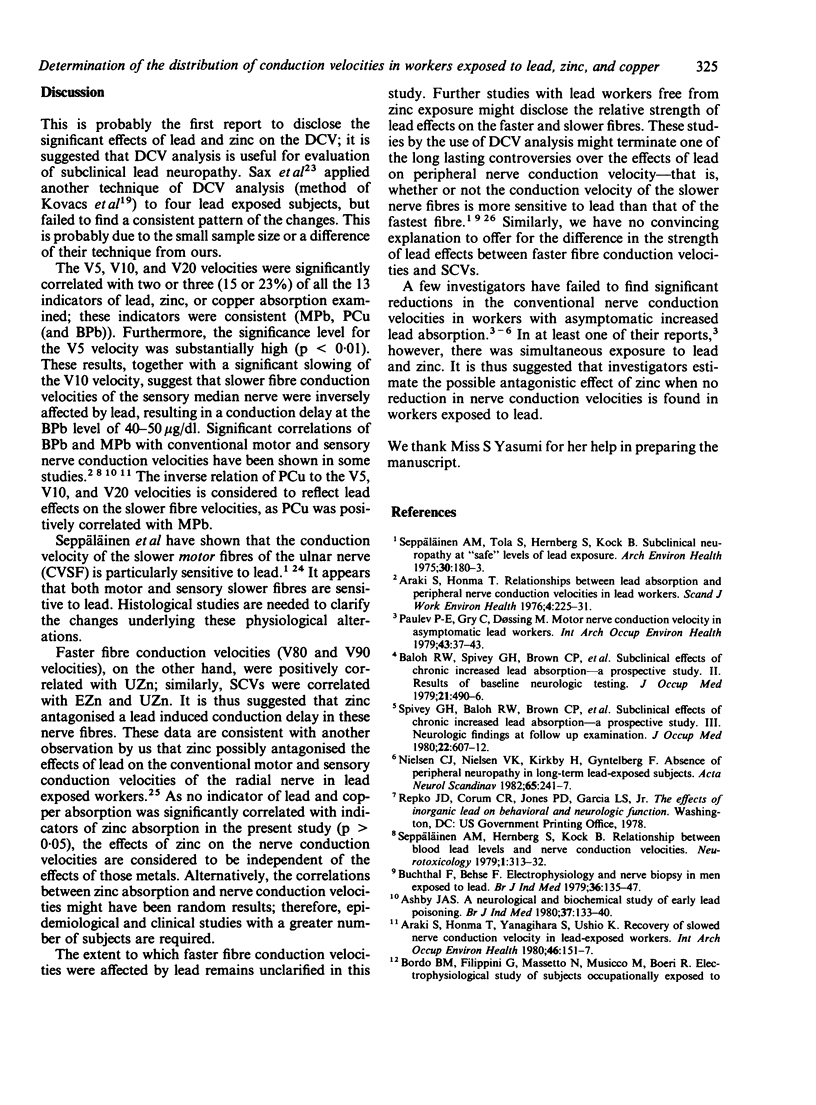
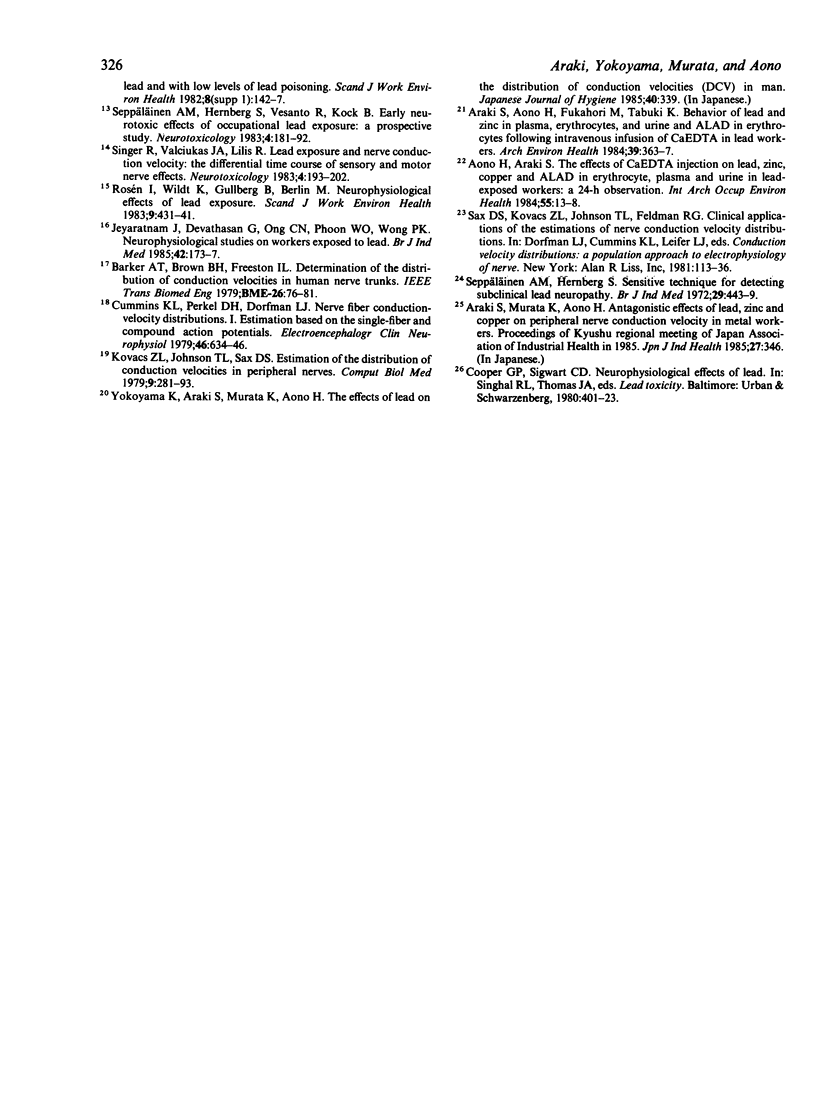
Selected References
These references are in PubMed. This may not be the complete list of references from this article.
- Aono H., Araki S. The effects of CaEDTA injection on lead, zinc, copper and ALAD in erythrocyte, plasma and urine in lead-exposed workers: a 24-h observation. Int Arch Occup Environ Health. 1984;55(1):13–18. doi: 10.1007/BF00378063. [DOI] [PubMed] [Google Scholar]
- Araki S., Aono H., Fukahori M., Tabuki K. Behavior of lead and zinc in plasma, erythrocytes, and urine and ALAD in erythrocytes following intravenous infusion of CaEDTA in lead workers. Arch Environ Health. 1984 Sep-Oct;39(5):363–367. doi: 10.1080/00039896.1984.10545865. [DOI] [PubMed] [Google Scholar]
- Araki S., Honma T. Relationships between lead absorption and peripheral nerve conduction velocities in lead workers. Scand J Work Environ Health. 1976 Dec;2(4):225–231. doi: 10.5271/sjweh.2800. [DOI] [PubMed] [Google Scholar]
- Araki S., Honma T., Yanagihara S., Ushio K. Recovery of slowed nerve conduction velocity in lead-exposed workers. Int Arch Occup Environ Health. 1980;46(2):151–157. doi: 10.1007/BF00378193. [DOI] [PubMed] [Google Scholar]
- Ashby J. A. A neurological and biochemical study of early lead poisoning. Br J Ind Med. 1980 May;37(2):133–140. doi: 10.1136/oem.37.2.133. [DOI] [PMC free article] [PubMed] [Google Scholar]
- Baloh R. W., Spivey G. H., Brown C. P., Morgan D., Campion D. S., Browdy B. L., Valentine J. L., Gonick H. C., Massey F. J., Jr, Culver B. D. Subclinical effects of chronic increased lead absorption--a prospective study. II. Results of baseline neurologic testing. J Occup Med. 1979 Jul;21(7):490–496. [PubMed] [Google Scholar]
- Barker A. T., Brown B. H., Freeston I. L. Determination of the distribution of conduction velocities in human nerve trunks. IEEE Trans Biomed Eng. 1979 Feb;26(2):76–81. doi: 10.1109/tbme.1979.326512. [DOI] [PubMed] [Google Scholar]
- Bordo B. M., Filippini G., Massetto N., Musicco M., Boeri R. Electrophysiological study of subjects occupationally exposed to lead and with low levels of lead poisoning. Scand J Work Environ Health. 1982;8 (Suppl 1):142–147. [PubMed] [Google Scholar]
- Buchthal F., Behse F. Electrophysiology and nerve biopsy in men exposed to lead. Br J Ind Med. 1979 May;36(2):135–147. doi: 10.1136/oem.36.2.135. [DOI] [PMC free article] [PubMed] [Google Scholar]
- Cummins K. L., Perkel D. H., Dorfman L. J. Nerve fiber conduction-velocity distributions. I. Estimation based on the single-fiber and compound action potentials. Electroencephalogr Clin Neurophysiol. 1979 Jun;46(6):634–646. doi: 10.1016/0013-4694(79)90101-9. [DOI] [PubMed] [Google Scholar]
- Jeyaratnam J., Devathasan G., Ong C. N., Phoon W. O., Wong P. K. Neurophysiological studies on workers exposed to lead. Br J Ind Med. 1985 Mar;42(3):173–177. doi: 10.1136/oem.42.3.173. [DOI] [PMC free article] [PubMed] [Google Scholar]
- Kovacs Z. L., Johnson T. L., Sax D. S. Estimation of the distribution of conduction velocities in peripheral nerves. Comput Biol Med. 1979;9(4):281–293. doi: 10.1016/0010-4825(79)90035-0. [DOI] [PubMed] [Google Scholar]
- Nielsen C. J., Nielsen V. K., Kirkby H., Gyntelberg F. Absence of peripheral neuropathy in long-term lead-exposed subjects. Acta Neurol Scand. 1982 Apr;65(4):241–247. doi: 10.1111/j.1600-0404.1982.tb03083.x. [DOI] [PubMed] [Google Scholar]
- Paulev P. E., Gry C., Døssing M. Motor nerve conduction velocity in asymptomatic lead workers. Int Arch Occup Environ Health. 1979 Mar 7;43(1):37–43. doi: 10.1007/BF00454278. [DOI] [PubMed] [Google Scholar]
- Rosén I., Wildt K., Gullberg B., Berlin M. Neurophysiological effects of lead exposure. Scand J Work Environ Health. 1983 Oct;9(5):431–441. doi: 10.5271/sjweh.2399. [DOI] [PubMed] [Google Scholar]
- Seppäläinen A. M., Hernberg S. Sensitive technique for detecting subclinical lead neuropathy. Br J Ind Med. 1972 Oct;29(4):443–449. doi: 10.1136/oem.29.4.443. [DOI] [PMC free article] [PubMed] [Google Scholar]
- Seppäläinen A. M., Hernberg S., Vesanto R., Kock B. Early neurotoxic effects of occupational lead exposure: a prospective study. Neurotoxicology. 1983 Summer;4(2):181–192. [PubMed] [Google Scholar]
- Seppäläinen A. M., Tola S., Hernberg S., Kock B. Subclinical neuropathy at "safe" levels of lead exposure. Arch Environ Health. 1975 Apr;30(4):180–183. doi: 10.1080/00039896.1975.10666672. [DOI] [PubMed] [Google Scholar]
- Singer R., Valciukas J. A., Lilis R. Lead exposure and nerve conduction velocity: the differential time course of sensory and motor nerve effects. Neurotoxicology. 1983 Summer;4(2):193–202. [PubMed] [Google Scholar]
- Spivey G. H., Baloh R. W., Brown C. P., Browdy B. L., Campion D. S., Valentine J. L., Morgan D. E., Culver B. D. Subclinical effects of chronic increased lead absorption--a prospective study. III. Neurologic findings at follow-up examination. J Occup Med. 1980 Sep;22(9):607–612. [PubMed] [Google Scholar]


